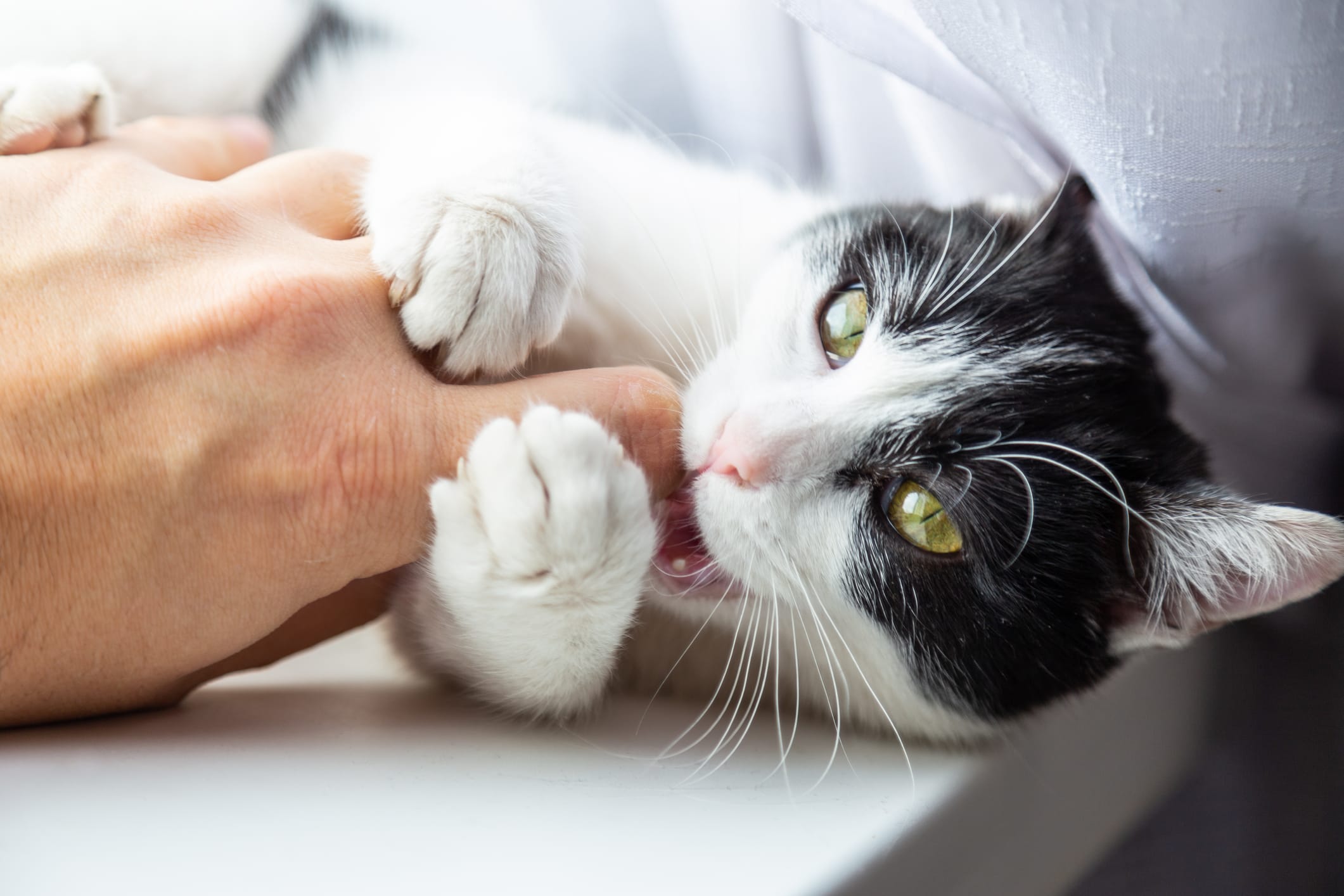My cat, Jasper, typically a sweetheart, launched a sudden, ferocious attack. One minute, purrs vibrated from his furry body; the next, claws and teeth were flying. It was terrifying and heartbreaking, leaving me bleeding and bewildered. This ordeal spurred a quest to understand what triggered this unexpected aggression. Could it have been overstimulation, redirected aggression, or even a hidden medical issue? Join me as I explore the possible reasons behind Jasper’s transformation and discover how to prevent future “furry freakouts” and rebuild trust with our feline friends.
Jasper’s Sudden Attack: A Purrfectly Peaceful Moment Turned Predatory
It happened in a flash. Jasper, my usually affectionate tabby, was enjoying a relaxing cuddle on my lap. Then, without warning, he morphed. Claws extended, teeth bared, he unleashed a furious assault. This wasn’t a playful nip; it was a full-blown attack, leaving me shocked and bleeding. My cuddly companion had become a tiny tiger. While it felt entirely unprovoked, was it truly?
Decoding the Attack: Was It Really Unprovoked?
The experience left me shaken, questioning everything I thought I knew about Jasper. Was this a one-time event, or a sign of a deeper issue? Had I missed subtle warnings? My search for answers led me into the fascinating world of feline behavior. It turns out that what we perceive as “unprovoked” aggression in cats is rarely truly unprovoked. Often, there are subtle triggers we humans simply miss.
The Whispers We Miss: Understanding Feline Communication
Cats, unlike their canine counterparts, are masters of subtle communication. They speak a language of twitches, flicks, ear positions, and pupil dilations. A twitching tail may signal growing irritation, not contentment. Flattened ears might suggest fear or anxiety, and dilated pupils can indicate overstimulation. These subtle cues often go unnoticed by us. Had Jasper been trying to communicate his discomfort, and had I ignored his pleas for space? Overstimulation, much like a child’s meltdown after excessive excitement, is a common trigger for feline aggression. Even a gentle touch can become unbearable for an overstimulated cat, leading to an outburst. Could this explain Jasper’s sudden shift?
Redirected Aggression: When a Squirrel Becomes a Cat-astrophe
Another potential explanation is redirected aggression. Picture Jasper, perched on the windowsill, fixated on a squirrel. His predatory instincts surge, but the window acts as a barrier. This thwarted hunting drive, like a pressure cooker releasing steam, can be redirected onto the nearest target – me. I became the unfortunate recipient of his frustrated energy.
A Medical Mystery? Exploring Potential Health Issues
Sudden behavioral changes can also suggest underlying medical problems. Pain, discomfort, or even cognitive decline can increase irritability and aggression in cats. Could Jasper’s outburst be a cry for help? A vet visit thankfully ruled out any physical ailments, but it highlighted the importance of seeking professional advice when a cat’s behavior changes drastically.
Preventing Future Fireworks: Rebuilding Our Bond
After researching feline behavior, I’m committed to strengthening my bond with Jasper and preventing future incidents. We’ve incorporated more interactive play sessions with wand toys, allowing him to channel his natural hunting instincts in a healthy way. I’m also learning to interpret his subtle body language, respecting his boundaries, and enriching his environment with climbing shelves, scratching posts, and puzzle feeders to alleviate stress and boredom.
| Potential Trigger | Signs to Watch For | Solution |
|---|---|---|
| Overstimulation | Tail twitching, ears flattened, pupils dilated, skin rippling | Stop interacting, give the cat space |
| Redirected Aggression | Staring intently at a window or other stimulus, sudden agitation | Redirect attention with a toy, remove the stimulus if possible |
| Medical Issues | Changes in appetite, lethargy, hiding, vocalization | Consult a veterinarian |
The memory of Jasper’s attack still lingers, but now, instead of fear, I feel empowered. I’m determined to understand his behavior, not just for my safety, but for his well-being. Deciphering the “why” is crucial for rebuilding trust and ensuring a peaceful coexistence. If you’ve experienced a similar situation, you’re not alone. With patience, understanding, and a little detective work, we can decode our cats’ complex language, transforming unexpected claws back into comforting purrs.
Why Does My Cat Aggressively Attack Me Out of Nowhere?
It’s jarring when your sweet feline suddenly turns into a miniature predator, seemingly without reason. One moment, purrs and cuddles; the next, scratches and bites. It’s natural to feel confused, hurt, and even afraid. But what appears “out of nowhere” to us rarely is for our feline companions. There’s usually a trigger, even if it’s not immediately apparent. Let’s explore some common reasons behind these surprising attacks.
Redirected aggression is a likely culprit. Imagine your cat, fixated on a squirrel outside, experiencing a surge of predatory excitement. When you interrupt their focus, you might become the target of their pent-up energy. It’s not personal; it’s an instinctive reaction. Removing the initial trigger, such as closing the blinds, can help.
Hidden pain or discomfort is another possibility. Cats are experts at masking illness or injury. What we perceive as aggression could be a cry for help. A medical condition like arthritis or a urinary tract infection can make a cat irritable. If your cat’s behavior changes suddenly, a veterinary visit is essential.
Kittens, while adorable, are also bundles of unpredictable energy. Their play can be rough, and their tiny claws and teeth are surprisingly sharp. What seems like aggression might be misplaced predatory instincts. Providing appropriate outlets for this energy, like interactive toys and regular play sessions, is crucial. Avoid using your hands as toys, as this teaches them that human skin is a plaything.
Fear and anxiety also contribute to feline aggression. Loud noises, strangers, or sudden movements can trigger a defensive response. Creating a safe, predictable environment is key. Gradual introductions to new people or objects, quiet hiding spaces, and calming pheromone diffusers can help.
Perhaps the most perplexing is aggression during seemingly affectionate interactions. You’re petting your purring cat, and suddenly – chomp! This petting-induced aggression usually indicates overstimulation. Cats have limits with physical contact. Learning to recognize their subtle body language cues, such as a twitching tail or dilated pupils, is crucial. Respecting these boundaries and stopping the petting before it becomes too much can prevent these unexpected nips and scratches.
Sensory overload is another factor to consider. Cats’ senses are far more acute than ours. Flickering lights, appliance hums, strong perfumes, or certain textures can contribute to sensory overload, leading to irritability and aggression. Creating a calm, quiet environment with minimal sensory stimulation can help, as can providing a designated quiet space.
| Possible Cause of Aggression | Signs and Symptoms | Possible Solutions |
|---|---|---|
| Redirected Aggression | Sudden attack after encountering another animal or stimulus; agitation and frustration | Remove or block the triggering stimulus; provide alternative outlets for energy |
| Underlying Medical Condition | Changes in behavior, appetite, or elimination habits; lethargy or increased vocalization | Consult a veterinarian for diagnosis and treatment |
| Play Aggression | Stalking, pouncing, and playful biting, especially in kittens | Provide appropriate toys and interactive play sessions; avoid using hands as toys |
| Fear/Anxiety | Hissing, spitting, growling, flattened ears, dilated pupils, hiding | Create a safe and predictable environment; gradual introductions to new stimuli; calming pheromones |
| Petting-Induced Overstimulation | Tail twitching, rippling skin, ears flattening, sudden biting or scratching during petting | Learn to recognize cat’s body language cues and stop petting before they become overstimulated |
| Sensory Overload | Increased irritability, hiding, aggression in response to specific stimuli | Minimize sensory stimulation; create a calm and quiet environment |
So, why does your cat attack seemingly “out of nowhere?” The answer is often multifaceted. It could be one of these factors, a combination, or something else entirely. Observing your cat’s behavior, considering their environment, and consulting with a veterinarian or qualified feline behaviorist are essential steps in understanding and addressing the root cause of their aggression. Remember, these seemingly random acts of violence are rarely truly random. With careful observation, a deeper understanding of your cat’s needs, and perhaps some professional guidance, you can create a more harmonious and peaceful relationship. Explore further and don’t hesitate to seek professional guidance when needed. You might even discover some interesting information about the melothria scabra, a unique plant with potential benefits, along the way.
What Do You Do When Your Cat Is Viciously Attacking You?
My usually affectionate calico, Mittens, shocked me one day with a sudden, vicious attack. While petting her, I felt teeth and claws sink into my hand. I froze, then carefully backed away, leaving her staring as if nothing had happened. This unexpected aggression spurred me to seek answers. A vet visit ruled out physical ailments, but research suggested redirected aggression. A stray cat had been lurking around, possibly triggering Mittens’s fear and frustration.
This incident taught me a crucial lesson: what to do when your cat attacks: Stay calm. Avoid yelling, hitting, or sudden movements, as these can escalate the situation. Gently push towards the cat to encourage release, then create distance. Once safe, analyze the situation. What preceded the attack? Were there potential stressors like loud noises or unfamiliar people? Understanding the context can help prevent future incidents.
Cats communicate through subtle body language. A twitching tail might indicate agitation, not happiness. Flattened ears often suggest fear, while dilated pupils signal stress. Learning to interpret these cues is key to understanding their emotions and avoiding triggering aggression.
Creating a harmonious environment is crucial. A dull environment can breed boredom, while a stressful one fosters anxiety. Both can lead to aggression. Enriching activities like puzzle toys, climbing shelves, and scratching posts are essential for a content cat.
After the attack, I felt hurt and confused, but I knew Mittens wasn’t acting out of malice. We’re rebuilding our bond, paying close attention to her signals, ensuring playtime and mental stimulation, and creating a calm environment. It’s a journey of learning and adapting. Even when the claws come out, the love remains. It’s about understanding the why and working together for a harmonious relationship. While we can’t always predict their actions, understanding can strengthen our bond.
Why Does My Cat Aggressively Bite Me Unprovoked?
My sweet Whiskers transformed into a furry ninja, sinking her teeth into my hand while being petted. Bewildered and hurt, I sought answers. Research revealed that “unprovoked” attacks are rarely truly unprovoked. We often miss their subtle signs of discontent. Perhaps Whiskers had signaled she’d had enough petting through a twitching tail or flattened ears, but I was oblivious.
So, why the seemingly unprovoked bite? The answer is often complex. Redirected aggression is a possibility. Perhaps she saw a squirrel outside, triggering her predatory instincts, and redirected her frustration towards me. Another possibility was pain, although a vet visit thankfully ruled that out. Fear, anxiety, and stress are also potential culprits. Cats are sensitive to sudden noises, changes in routine, or new furniture. Even a seemingly random bite can be their way of expressing discomfort.
Armed with this new knowledge, I started observing Whiskers more closely, learning to differentiate between a playful nip and a warning bite. I also enriched her environment with climbing shelves, scratching posts, and puzzle feeders, reducing boredom and stress. Interactive play with wand toys became our new bonding ritual, channeling her hunting instincts healthily.
| Potential Trigger | Cat’s Behavior | Your Response |
|---|---|---|
- Red Cloud, NE: Discover Willa Cather’s Legacy - April 11, 2025
- Remember Old Social Media Sites? Their Rise and Fall - April 11, 2025
- How many days till Feb 3?Accurate Countdowns & Tools - April 11, 2025

















1 thought on “Why Did My Cat Viciously Attack Me Unprovoked? Understanding Feline Aggression”
Comments are closed.